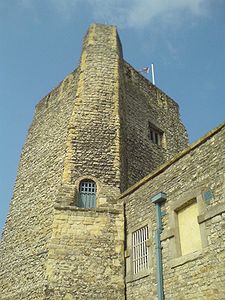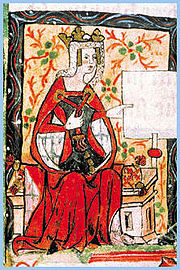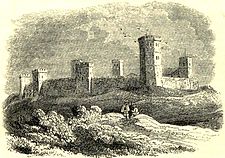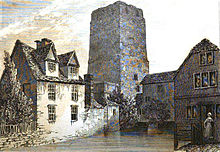- Oxford Castle
-
Oxford Castle Oxfordshire, England
St George's Tower, Oxford CastleType Shell keep and bailey Coordinates grid reference SP509063 Construction
materialsCoral rag and gravel Current
conditionRuined, elements used as an hotel Current
ownerOxfordshire County Council Oxford Castle is a large, partly ruined Norman medieval castle situated on the west edge of Oxford in Oxfordshire, England. The original moated, wooden motte and bailey castle was replaced with stone in the 11th century and played an important role in the conflict of the Anarchy. In the 14th century the military value of the castle diminished and the site became used primarily for county administration and for detaining prisoners. Most of the castle was destroyed during the English Civil War and by the 18th century the remaining buildings were used as Oxford's local prison. A new prison complex was built on the site from 1785 onwards and expanded in 1876; this ultimately became HM Prison Oxford. The prison closed in 1996 and was redeveloped as a hotel. Today the medieval remains of the castle, including the motte and St George's Tower, are classed as a Grade I listed building and as a Scheduled Monument.
Contents
History
Construction
According to the Abingdon Chronicle,[1] Oxford Castle was built by the Norman baron, Robert D'Oyly the senior from 1071-3.[2] D'Oyly had arrived in England with William I during the Norman Conquest of England in 1066 and was granted extensive lands in Oxfordshire.[2] Oxford had been stormed during the invasion with considerable damage, and William instructed D'Oyly to build a castle to dominate the town.[3] In due course D'Oyly became the pre-eminent landowner in Oxfordshire and was confirmed with a hereditary royal constableship for Oxford Castle.[4] Oxford Castle was not amongst the 48 mentioned in the Domesday Book of 1086, however not every castle in existence at the time was recorded in the survey.[5]
D'Oyly positioned his castle to the west side of the town, using the natural protection of a stream of the River Thames on the far side of the castle, now known as Castle Mill Stream, and diverting the stream to produce a moat.[6] There has been debate as to whether there was an earlier English fortification on the site, but whilst there is archaeological evidence of earlier Anglo-Saxon habitation there is no conclusive evidence of fortification.[6] Although Oxford Castle was clearly an "urban castle" it remains uncertain if local buildings had to be demolished to make room for the castle; the Domesday Book does not record any demolition, so the land may have already been empty due to the damage caused by the Norman seizure of the town.[7] Alternatively the castle may have been imposed over an existing street frontage which would have required the demolition of at least several houses.[8]
 Oxford Castle, around 1250. A: The keep and motte; B: St George's Tower and Chapel; C: The Round Tower; D: River Isis; E: Moat; F: City wall; G: West Gate; H: Barbican[9]
Oxford Castle, around 1250. A: The keep and motte; B: St George's Tower and Chapel; C: The Round Tower; D: River Isis; E: Moat; F: City wall; G: West Gate; H: Barbican[9]
The initial castle was probably a large motte and bailey design, copying the design of the castle that D'Oyly had already built twelve miles away at Wallingford.[6] The motte was originally around 60 ft (18m) high and 40 ft (12m) wide, constructed like the bailey from layers of gravel and strengthened with clay facing.[10] There has been debate over the sequencing of the motte and the bailey; it has been suggested that the bailey may have built first, which would make the initial castle design a ringwork rather than a motte and bailey.[11]
By the mid-12th century Oxford Castle had been significantly extended in stone. The first such work was St George's Tower, built of coral rag stone in 1074, 30 ft by 30 ft (9m by 9m) at the base and tapering significantly towards the top for stability.[12] This particular tower was the tallest of the castle towers, possibly because it covered the approach to the old west gate of the city, and included a chapel and a crypt on the inside of the walls.[13] It is possible that the stone chapel itself may have built on the site of a previous church on the same site.[11] St George's chapel was endowed with a college of priests by D'Oyly and his close friend, Roger d'Ivry in 1074, and originally enjoyed a nave, chancel and an apsidal sanctuary; the crypt was a typical early Norman design with solid pillars and arches.[14]
The wooden keep was replaced with a ten-sided stone shell keep, 58 ft (18m) wide on top of the mound, closely resembling similar structures at Tonbridge and Arundel Castles.[15] The keep included a number of buildings, leaving an inner courtyard only 22 ft (7m) across.[16] Stairs led down from within the keep to an underground 12 ft (4m) wide hexagonal stone chamber, containing a 54 ft (16m) deep well providing water supplies in the event of siege.[17]
Role in the Anarchy and Barons War
Robert D'Oyly the younger, Robert D'Oyly the senior's nephew, inherited the castle by the time of the civil war of the Anarchy in the 1140s.[2] After initially supporting King Stephen, Robert declared his support for Empress Matilda, Stephen's rival for the throne, and in 1141 the Empress marched to Oxford to use the castle as her base of operations.[18] Stephen responded by marching unexpectedly from Bristol in December, attacking and seizing the town of Oxford and besieging Matilda in the castle.[16] Stephen set up two large mounds alongside the castle, called Jew's Mount and Mount Pelham, on which he placed siege engines, largely for show, and proceeded to wait for Matilda's supplies to run low over the next three months.[15] Stephen himself would have had difficulty in supplying his men through the winter period, and this decision shows the apparent strength of Oxford Castle at this time.[19]
Matilda responded to her predicament by escaping from the castle; the popular version of this has the Empress waiting until the Castle Mill Stream was frozen over and then dressed in white to act as camouflage in the snow, being lowered down the walls with three or four knights, before escaping through Stephen's lines in the night whilst the king's sentries attempted to raise the alarm.[15] The chronicler William of Malmesbury, however, suggests that Matilda did not climb down the walls, but instead escaped from one of the gates.[19] Matilda reached Abingdon safely and Oxford Castle surrendered to Stephen the following day.[15] Robert had died during the final weeks of the siege and the castle was given to William de Chesney for the remainder of the war.[20] At the end of the war the constableship of Oxford Castle was granted to Roger de Bussy before being reclaimed by Henry D'Oyly, Robert D'Oyly the younger's son, in 1154.[21]
In the Barons' War of 1215–7 the castle was attacked again, leading to further improvements in its defences.[22] In 1220 Falkes de Breauté, who controlled many royal castle in the middle of England, demolished the Church of St Budoc to the south-east of the castle and built a moated barbican to further defend the main gate.[23] The remaining wooden buildings were replaced in stone, including the new Round Tower which was built in 1235.[24] King Henry III turned part of the castle into a prison, specifically for holding troublesome University clerks, and also improved the castle chapel, replacing the older barred windows with stained glass in 1243 and 1246.[25] Due to the presence of Beaumont Palace to the north of Oxford, however, the castle never became a royal residence.[26]
14th–17th centuries
By 1327 the fortification, particularly the castle gates and the barbican, was in poor condition and £800 was estimated to be required for repairs.[27] From the 1350s onwards the castle had little military utility and was increasingly allowed to fall into disrepair.[22] The castle became the centre for the administration of the county of Oxford, and gaol and assizes were held there until 1577, when plague broke out during what became known as the "Black Assizes": the Lord Lieutenant of Oxfordshire, two knights, eighty gentlemen and the entire grand jury for the session all died, including Sir Robert D'Oyley, a relative of the founder of the castle.[28] In the aftermath the castle was abandoned as a location for future hearings.[28]
By the 16th century the barbican had been dismantled to make way for houses and the moat had begun to be reoccupied for housing; by 1600 the moat was almost entirely silted up and houses had been built all around the edge of the bailey wall.[29] In 1611 King James I then sold Oxford Castle to Francis James and Robert Younglove, who in turn sold the property to Christ Church College in 1613; the college then leased it to a number of local families over the coming years.[30] By this time Oxford Castle was in a weakened state, with a large crack running down the side of the keep.[31]
In 1642 the English Civil War broke out, with the city of Oxford becoming the capital of the Royalist faction. Parliamentary forces successfully besieged Oxford in 1646 and the city was occupied by Colonel Ingoldsby.[32] Ingoldsby focussed on improving the fortification of the castle rather than the surrounding town, and in 1649 pulled down most of the medieval stonework, replacing it with more modern earth bulwarks and reinforcing the keep with earth works to form a probable gun-platform.[33] In 1652, during the third English Civil War, the Parliamentary garrison responded to the proximity of Charles II's forces by pulling down these defences as well and retreating to New College instead, causing great damage to the college in the process.[32] In the event, Oxford saw no fresh fighting; early in the 18th century, however, the keep was finally pulled down and the top of the motte landscaped to form its current condition.[31]
Role as prison
Oxford Castle was primarily used after the Civil War as the local prison.[34] Like other prisons at the time, the property was leased out by the owners, in this case Christ Church College, to wardens who would make their profit by charging prisoners for their food and accommodation.[34] The prison also contained a gallows for the execution of prisoners, such as the notorious Mary Blandy in 1752.[35] For most of the 18th century the castle prison was run by the local Etty and Wisdom families and in increasing disrepair.[36] In the 1770s the castle was visited several times by the prison reformer John Howard, who criticised the size and quality of the establishment, including the extent of the vermin that invested the prison.[37] Partially as a result of this critique, the decision was taken to rebuild the Oxford Prison.[38]
In 1785 the castle site was purchased by the Oxford County Justices and rebuilding commenced under the London architect William Blackburn.[39] The wider castle site had already begun to change by the late 18th century, with New Road being built through the bailey and the last parts of the castle moat being filled in to allow the construction of the new canal terminus in Oxford.[22] The new prison build resulted in the destruction of the old college attached to St George's chapel, and the repositioning of part of the crypt; the work was finally completed by Daniel Harris in 1805.[40] Harris acquired a reasonable salary as the new governor and used convict labour from the prison to conduct early archaeological excavations at the castle with the help of the antiquarian Edward King.[41]
In the 19th century the site continued to be developed, with various new buildings constructed, including the new County Hall, the Militia Armoury; the prison itself was extended in 1876, growing to occupy most of the remaining space.[22] In 1888 national prison reforms led to the renaming of the county prison as HM Prison Oxford.
Today
The prison was closed in 1996 and the site reverted to Oxfordshire County Council. The remains of the castle are classed as a Grade I listed building and as a Scheduled Monument.[42] Still visible is the castle motte, St George's Tower and the crypt.
The Oxford Prison buildings have since been redeveloped as a shopping and heritage complex, with guided tours of the historic buildings and open courtyards for markets and theatrical performances. The complex includes a hotel in the Malmaison chain, Malmaison Oxford, occupying a large part of the former prison block, with converted jail cells as guest rooms; those parts of the prison associated with corporal or capital punishment, however, have been converted to offices rather than being used for guests.[43]
References
- ^ Referenced in Harfield, p.388.
- ^ a b c Joy, p.28.
- ^ MacKenzie, 147; Tyack, p.5.
- ^ Amt, pp.47–8.
- ^ Harfield, pp.384, 388–9.
- ^ a b c MacKenzie, p.147.
- ^ Jope, p.79; Creighton, p.146.
- ^ Tyack, p.5; Creighton, p.148.
- ^ Map drawn after Hassall 1971, p.2; Tyack, p.6, p.80.
- ^ MacKenzie, p.148; Oxford Archaeology, accessed 12 September 2010.
- ^ a b Hassall 1976, p.233.
- ^ Tyack, p.7; MacKenzie, p.148.
- ^ Tyack, p.6; Hassall 1976, p.233.
- ^ Tyack, p.8.
- ^ a b c d MacKenzie, p.149; Gravett and Hook, p.43.
- ^ a b MacKenzie, p.149.
- ^ Tyack, p.8; MacKenzie, p.149.
- ^ MacKenzie, p.149; Amt, p.48.
- ^ a b Gravett and Hook, p.44.
- ^ Amt, p.48.
- ^ Amt, pp56-7.
- ^ a b c d Hassall, p.235.
- ^ Hassall 1971, p.9.
- ^ Hassall 1976, p.235; Tyack, p.8.
- ^ Davies, p.3; Marks, p.93.
- ^ Munby, p.96.
- ^ Crossley and Elrington, p.297.
- ^ a b Tyack, p.8; Hassall 1976, p.235; MacKenzie, p.149; Davies, pp.91–2.
- ^ Hassall 1976, p.235, 254.
- ^ Davies, p.3.
- ^ a b Oxford Archaeology, accessed 12 September 2010.
- ^ a b Joy, p.29.
- ^ Joy, p.29; Oxford Archaeology, accessed 12 September 2010.
- ^ a b Davies, p.6.
- ^ Davies, p.106.
- ^ Davies, pp.9–10.
- ^ Davies, p.14.
- ^ Davies, p.15.
- ^ Hassall 1976, p.235; Whiting, p.54.
- ^ Hyack, p.7; Whiting, p.54.
- ^ Munby, p.53; Davies, p.24.
- ^ National Monuments Record, accessed 25 September 2010.
- ^ Smith, p.93.
Bibliography
- Amt, Emilie. (1993) The Accession of Henry II in England: Royal Government Restored, 1149-1159. Woodbridge, UK: Boydell Press. ISBN 978-0-85115-348-3.
- Creighton, O. H. (2002) Castles and Landscapes: Power, Community and Fortification in Medieval England. London: Equinox. ISBN 9781904768678.
- Crossley, Alan and C. Elrington. (eds) (1979) Victoria County History: A History of the County of Oxford, Volume 4: The City of Oxford. OCLC 7534514.
- Davies, Mark. (2001) Stories of Oxford Castle: From Dungeon to Dunghill. Oxford: Oxford Towpath Press. ISBN 093559335.
- Gravett, Christopher and Adam Hook. (2003) Norman Stone Castles: The British Isles, 1066-1216. Botley, UK: Osprey. ISBN 978-1-84176-602-7.
- Harfield, C. G. (1991). "A Hand-list of Castles Recorded in the Domesday Book". English Historical Review 106: 371–392. JSTOR 573107.
- Harrison, Colin. (ed) (1998) John Malchair of Oxford: Artist and Musician. Oxford: Ashmolean Museum. ISBN 978-1-85444-112-6.
- Hassall, T. G. (1971) "Excavations at Oxford," in Oxoniesia, XXXVI (1971).
- Hassall, T. G. (1976) "Excavations at Oxford Castle: 1965-1973," in Oxoniesia, XLI (1976).
- Jope, E. M. "Late Saxon Pits Under Oxford Castle Mound: Excavations in 1952," in Oxonesia, XVII-XVIII (1952–1953).
- Joy, T. (1831) Oxford Delineated: A sketch of the history and antiquities. Oxford: Whessell & Bartlett. OCLC 23436981.
- MacKenzie, James Dixon. (1896/2009) The Castles of England: Their Story and Structure. General Books LLC. ISBN 978-1-150-51044-1.
- Marks, Richard. (1993) Stained glass in England during the Middle Ages. London: Routledge. ISBN 978-0-415-03345-9.
- Munby, Julian. (1998) "Malchair and the Oxford Topographical Tradition," in Harrison (ed) 1998.
- Smith, Philip. (2008) Punishment and Culture. Chicago: University of Chicago Press. ISBN 9780226766102.
- Tyack, Geoffrey. (1998) Oxford: an Architectural Guide. Oxford: Oxford University Press. ISBN 978-0-19-817423-3.
- Whiting, R. C. (1993) Oxford: Studies in the History of a University Town Since 1800. Manchester: Manchester University Press. ISBN 978-0-7190-3057-4.
External links
- Gatehouse Website record for Oxford Castle
- Oxford Castle Visitor Attraction
- Oxford Prison Hotel
- What's on at the Oxford Castle
Coordinates: 51°45′06″N 1°15′45″W / 51.75180°N 1.26248°W
Prisons in South East England Active Aylesbury · Blantyre House · Bronzefield · Bullingdon · Canterbury · Coldingley · Cookham Wood · Downview · East Sutton Park · Elmley · Ford · Grendon · High Down · Huntercombe · Isle of Wight (Albany, Camp Hill, Parkhurst) · Kingston · Lewes · Maidstone · Reading · Rochester · Send · Spring Hill · Standford Hill · Swaleside · Winchester · Woodhill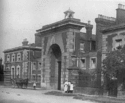
Defunct Categories:- Castles in Oxfordshire
- Defunct prisons in England
- Grade I listed buildings in Oxford
- Grade I listed castles
- Grade I listed prison buildings
- History of Oxford
- Hotels in Oxford
- Norman architecture
- Visitor attractions in Oxford
- 1071 establishments
- 1070s architecture
- Buildings and structures in Oxford
- Prison museums in the United Kingdom
- Museums in Oxfordshire
Wikimedia Foundation. 2010.

